35.995756, -78.902381
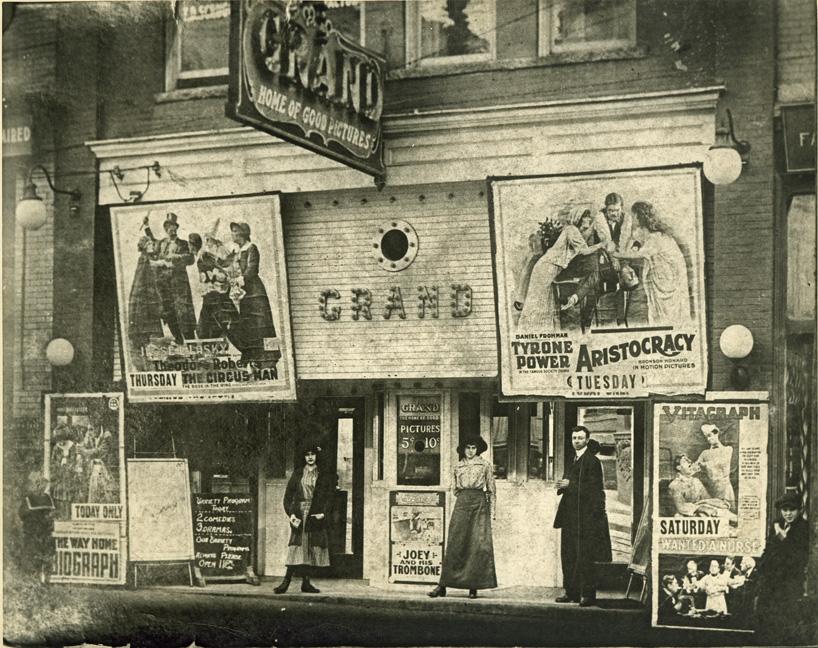
211 West Main ~1914.
(Courtesy Duke Rare Book and Manuscript Collection)
211 West Main has led a very varied life - it appears to have been constructed ~1910, supplanting an earlier frame structure. The Grand theater opened for business at the location in 1914.
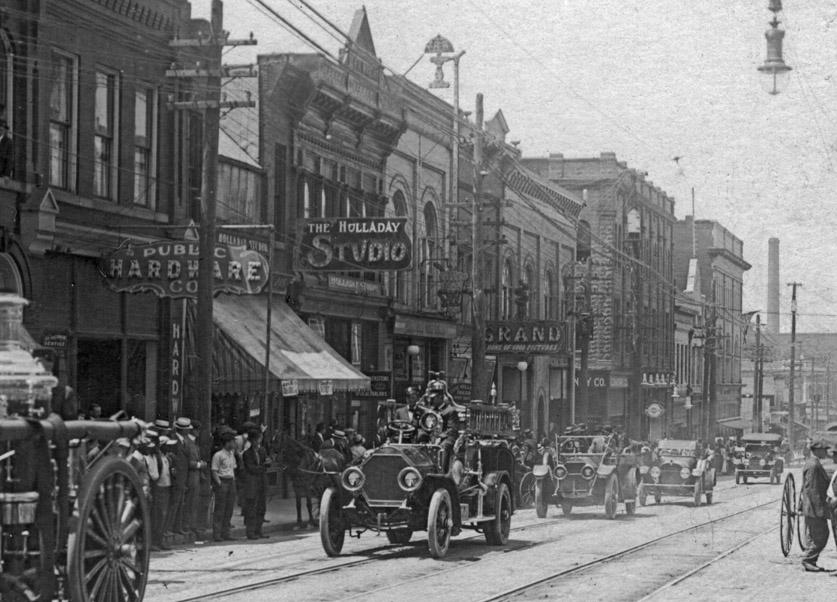
200 block of West Main St., 1910s.
(Courtesy Duke Rare Book and Manuscript Collection)
By the early 1920s, the Grand had become the Savoy theater, but by the mid-1920s, it was no longer in business.
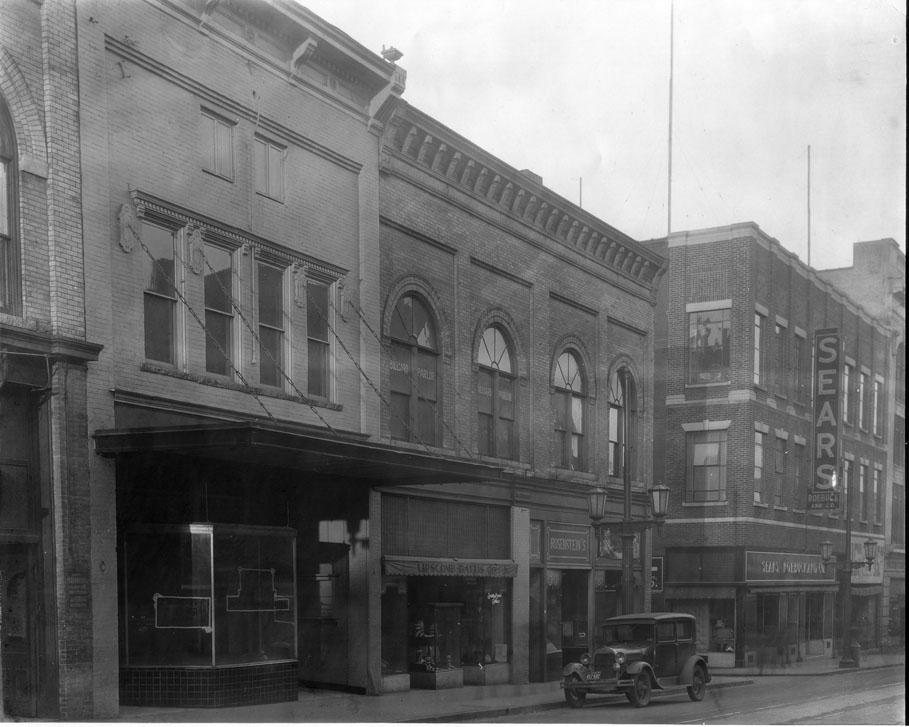
Looking southwest with 211 West Main in the foreground.
(Courtesy Durham County Library / North Carolina Collection)
In the 1950s, the facade was dramatically remodeled for the Lipscomb-Gattis department store, which had started as the Gattis-Newton company next door in the Jordan building.
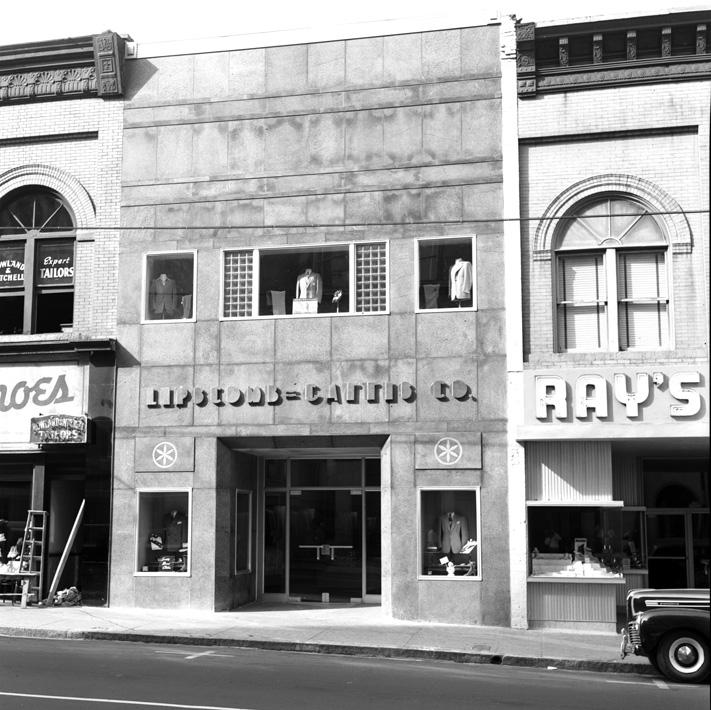
211 W Main, 1950s.
(Courtesy The Herald-Sun Newspaper)
The demolition of the three buildings to the east of 211 for a new Thalhimer's department store in the early 1960s left Lipscomb-Gattis intact. However, after the Thalhimers was renovated in the early 1970s for a new Wachovia building, the front facade of 211 West Main was completely obliterated - becoming a flat, black panel.
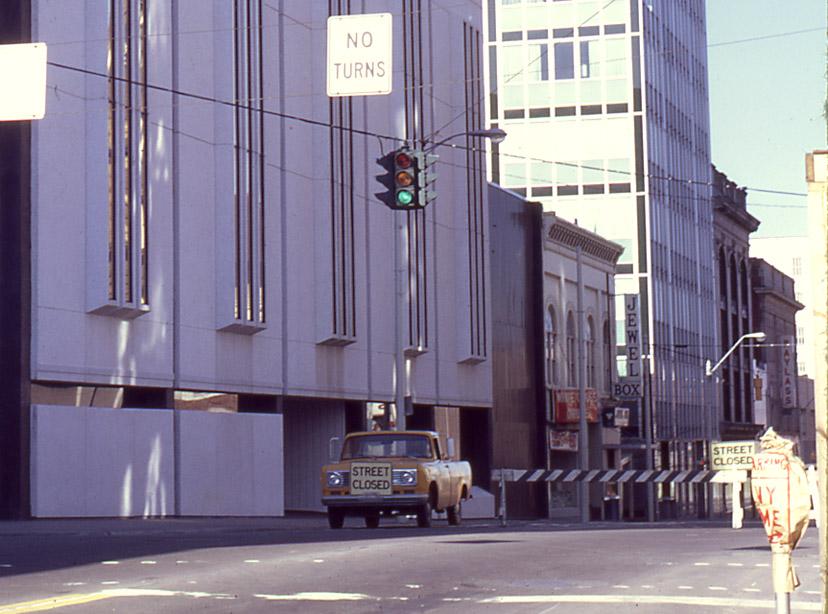
Looking southwest, early 1970s.
(Courtesy Durham County Library / North Carolina Collection)
When Self-Help remodeled the former Wachovia bank building, they added a bit of character back to the front of 211 West Main St. in the form of a brightly colored facade with a few windows. Although it could use a front door again, it's certainly far more cheerful and interesting than the Kubrickian, full-of-stars architectural style.
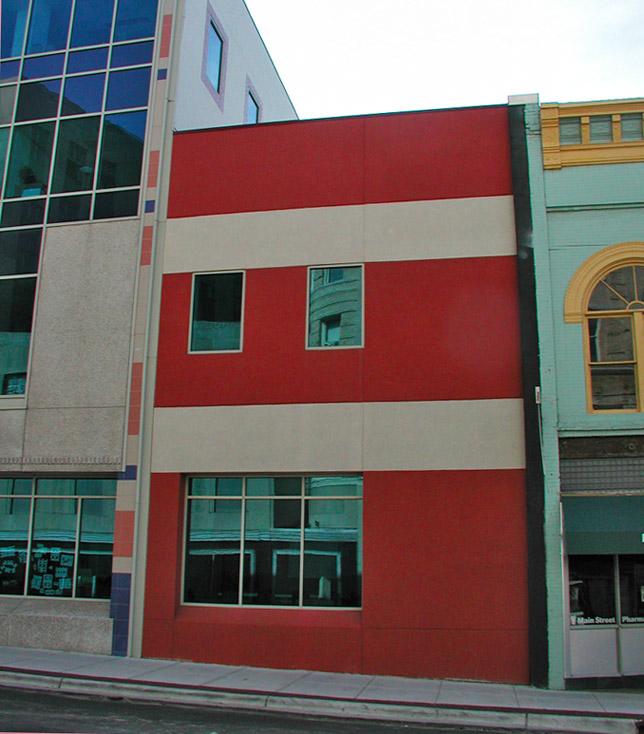
211 West Main, 02.04.07
Find this spot on a Google Map.
35.995756,-78.902381

Comments
Submitted by Tycho (not verified) on Mon, 2/8/2010 - 5:01am
Great picture of the Grand. And in case anyone is wondering, the Tyrone Power on the poster was a noted Broadway and film actor, and the father of the 1940s/1950s film star.
Submitted by MK (not verified) on Mon, 2/8/2010 - 11:26am
Tycho, thanks for that information. My immediate reaction to seeing the poster was "Surely he wasn't THAT old!"
Submitted by Anonymous (not verified) on Mon, 2/8/2010 - 1:18pm
Welcome back, Gary. We have missed our daily "return to yesteryear".
Submitted by John Martin (not verified) on Mon, 2/8/2010 - 1:56pm
I don't believe that the Thalheimers building was ever demolished as you state. When Thalheimers pulled out of downtown, the building was remodeled for Wachovia.
Submitted by Gary (not verified) on Mon, 2/8/2010 - 2:00pm
John, I can't get a definitive answer on this. I've heard an equal number of people say it was remodeled as say it was demolished and rebuilt. I'll change the post to say this.
GK
Submitted by Anonymous (not verified) on Mon, 2/8/2010 - 3:18pm
The Thalheimers building was heavily remodeled, but a walk through the lobby of the "bank" shows the department store roots. In the back were a set of escalators that lead to the second level of the store. I had a friend whose law firm moved into the building after the renovation and I used to use that escalator, as I had when the store was there. I feel certain there would be record evidence of this renovation in the City building permit files... or in Herald Sun accounts of the opening of the new Wachovia when they moved across the street.
lwn
Submitted by Gary (not verified) on Mon, 2/8/2010 - 3:25pm
A source with knowledge of the renovation has corroborated that the old Thalheimer's escalators were still in place when the Self-Help remodel was done. I've changed the post to reflect this.
GK
Submitted by Anonymous (not verified) on Mon, 2/8/2010 - 6:05pm
Spelling correction: Thalhimer's
As hard to remember as Croasdaile!
Submitted by Gary (not verified) on Mon, 2/8/2010 - 6:13pm
Thanks. Fixed.
Submitted by Andrew Edmonds (not verified) on Tue, 2/9/2010 - 3:19am
The addresses listed in the City Directories are sometimes a bit confusing, but I am under the impression that 211 West Main Street was also home to the Electric (1909-1910) and Broadway (1916-1921) Theatres. The wonderful UNC website, Going to the Show, corroborates this opinion.
[http://docsouth.unc.edu/gtts/venue/344]
Gary's 2007 entry on 213 West Main Street includes two photos of 211: the fourth down reveals the vertical BROADWAY sign; the fifth down shows what is presumably the Savoy Theatre on the left.
[http://endangereddurham.blogspot.com/2007/02/jordan-building.html]
===
Wyatt Dixon wrote extensively in his column about this site.
From his article on June 7, 1943:
“The Grand was not a grand theatre under the same yardstick that measures the modern theatres of today, but it was one of the best of that period and it served the entertainment requirements of the community for several years. During those days when Durham’s population was much smaller than today, and when the lack of many automobiles and good roads restricted the movie audience to local citizens, the program was changed daily to assure large audiences…
“The building was converted into a theatre by CE Jourdan, for many years engaged in the grocery business. The projection room was located in a stuffy, poorly ventilated place over the outside lobby of the theatre, and its only window was a small, porthole through which the operator could stick his head for an occasional breath of fresh air. The price of admission to all of the shows was five cents for children and 10 cents for adults…
“Jourdan operated the theatre until about 1917 when the amusement center was leased to RD Craver of Charlotte, and it then became a link in a big motion picture theatre chain. Craver changed the name of the theatre to the Broadway, necessitating the removal of the big electric sign that hung over the sidewalk in front of the theatre. With the acquisition of the theatre by the Charlotte interests a stage was erected in the building, vaudeville was added to the motion picture program, and for a time the services of an orchestra were procured.
“After an indeterminate period of operation, Craver sold the theatre here to the National Amusement Company of Greensboro, and it was operated as the Savoy until competition, which bought better theatres, caused the doors to close. The building then returned to its former sphere of service as a store.
“On the west side of the Jourdan building the Patterson grocery store was operated for several years. It was Durham’s first de luxe grocery, while over the grocery store Percy T Elliott operated his real estate office.”
Submitted by Andrew Edmonds (not verified) on Tue, 2/9/2010 - 3:20am
... here's some more ...
Later, from his January 17, 1975 column Dixon wrote that the Electric “had the distinction of being the first to show motion pictures in sound in local history. The historical event occurred on Monday, Feb. 6 [1909]. The theatre opened its doors at 2pm and showed to capacity audiences until 11 o’clock in the evening…
“[O]ne of the critics wrote:
The Electric Theater is the first to introduce the Cameraphone and it drew last night like a porous plaster. The Cameraphone flashes the picture and gives the line of talk right off the canvas. While the singers’ lips move, or there is colloquy, the audience can see and hear as in actual life and it is wonderfully adapted. The picture worked fine yesterday.
The Electric pictures last night were good for phone arrangement. The colored high fire life marriage brought a laugh with the first and only scrap. The songs are good. The whole thing is good.
“Nearly a score of years passed before talking pictures again appeared in Durham…
“Only a portion of that first film was in sound. The sound portions were recordings. Two operators were required in the projection room [Center Theater manager Charles H] Lewis said. One of them operated the projection machine. The other’s job was to see that the recording was perfectly synchronized with the lip movements of the actors.”
===
Finally, from his May 11, 1979 article:
“The Electric Theater operated for only a few years. In celebrating its first anniversary, the theater gave flowers as special favors to the women attending the theater on the occasion, the men received a cigar and the children were given a box of candy."
===
Dixon also identified the folks in the 1914 picture which Gary has added at the top of this post. They were Miss Grace Muse, Miss Norwood (cashier), and Wallace Hunt (doorman). Dixon mentions other staff in the 1943 article: Clarence Dority (projection machine operator), Miss Felicia Kueffner cum Mrs IL Sears (pianist), and Professor Coleman, violinist. “During periods of each day the pictures were presented without musical accompaniment.”
The UNC Going to the Show website features other nuggets of cultural ephemera, such as advertisements of these theatres from the newspapers. The Durham High School yearbooks were also popular places to advertise.
Submitted by Toby (not verified) on Fri, 2/12/2010 - 8:29pm
Is that black circle under the word "GRAND" in the 1914 photo the porthole referred to in the Wyatt Dixon piece excerpted by Andrew in the previous comment? (I can picture the projectionist sticking his head through there on a hot summer afternoon, chatting with passersby...)
Submitted by Jim Webster on Mon, 8/26/2013 - 5:06pm
Where might the old Endangered Durham link be for the Jordan Building?
I had relatives that owned the White Elephant Club social club (later White Elephant billiards) at 213 1/2 West Main Street from 1922 until 1932. It started out in 1921 at 107 1/2 North Church Street.
Submitted by gary on Mon, 8/26/2013 - 6:12pm
Jim - the link is here:
http://www.opendurham.org/buildings/jordan-building
Add new comment
Log in or register to post comments.